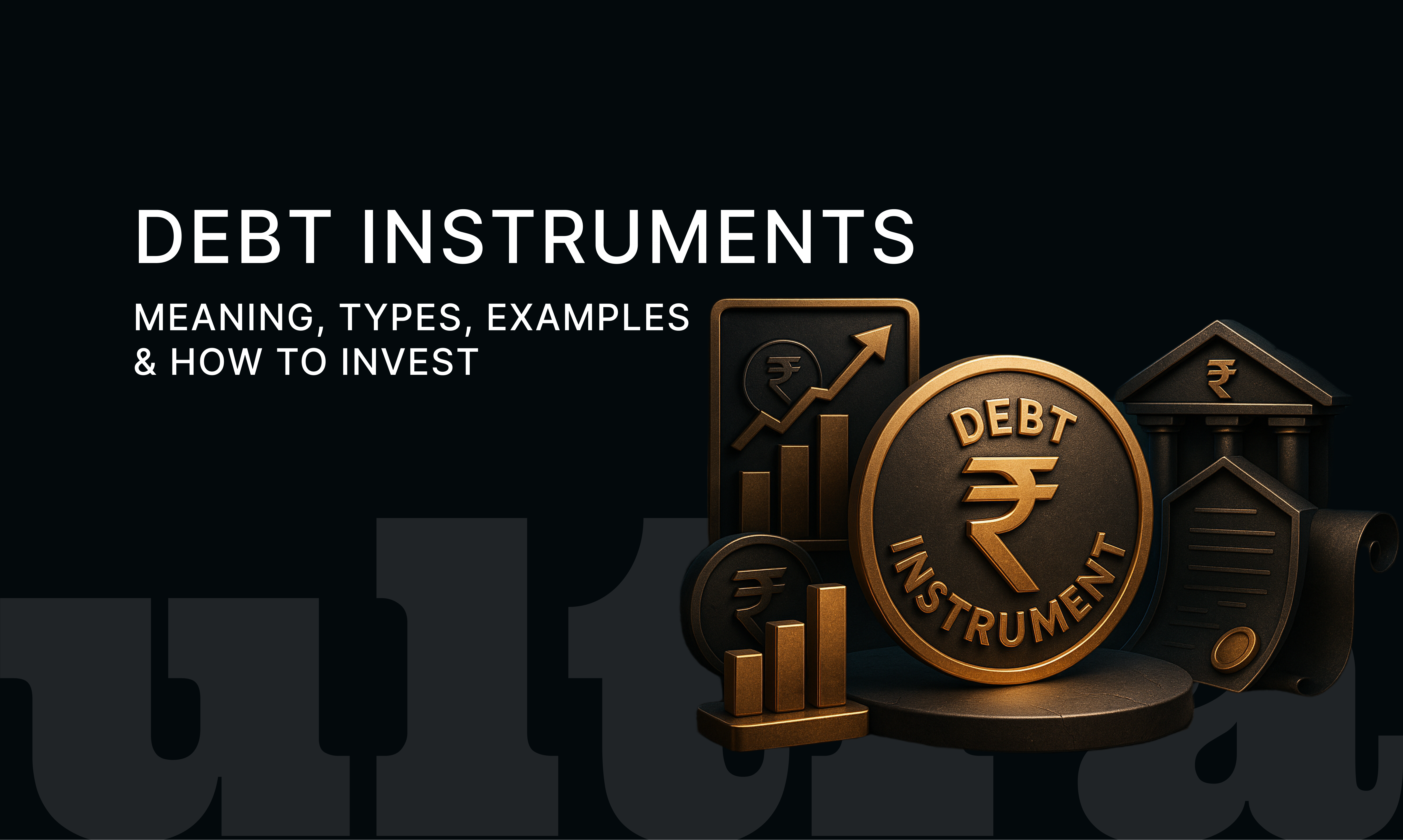Debt Instruments in India: Meaning, Types, Examples & How to Invest
24 July 2025 · Sachin Gadekar
What Are Debt Instruments? Meaning, Types, Examples, and Investment Guide

What Are Debt Instruments?
A debt instrument is a fixed-income asset where the issuer promises to repay the borrowed amount along with interest to the investor within a specified period.
In simple words, when you buy a debt instrument, you lend money to the issuer (which could be a government, company, or financial institution) in exchange for regular interest payments and the return of your principal at maturity.
Key Features of Debt Instruments
Fixed or floating interest income
Defined maturity period
Comparatively lower risk than stocks
Used by governments and companies to raise capital
Tradable on exchanges in some cases
Why Do Investors Choose Debt Instruments?
Investors often choose debt instruments for:
Capital preservation
Regular interest income
Portfolio diversification
Balancing risk exposure during market volatility
Predictable returns compared to equities
Types of Debt Instruments in India
Debt instruments in India can be classified into various types based on issuers, risk levels, tenure, and tradability. Here are some popular ones:
1. Government Securities (G-Secs)
Issued by the Central or State Governments, these are the safest debt instruments in India. Examples include Treasury Bills (T-Bills) and Government Bonds.
Who should invest?
Ideal for risk-averse investors looking for guaranteed returns.
2. Corporate Bonds
Companies issue corporate bonds to raise funds for expansion or operations. These generally offer higher interest than government bonds but carry credit risk depending on the company’s financial health.
Example: Non-Convertible Debentures (NCDs).
3. Municipal Bonds
Issued by municipal corporations or local government bodies to fund civic projects like roads or sanitation infrastructure.
4. Debentures
A debenture is a type of long-term debt instrument issued by companies to borrow funds at a fixed rate of interest. It may be secured or unsecured.
5. Commercial Papers (CPs)
Short-term unsecured debt instruments issued by companies to meet working capital needs. They generally have a maturity of up to one year.
6. Certificates of Deposit (CDs)
Issued by banks and financial institutions for a short tenure (up to one year). They offer higher returns than savings accounts.
7. Fixed Deposits (FDs)
Traditional yet widely used. Fixed deposits by banks or NBFCs are considered safe debt instruments offering fixed returns over a specific period.
8. Bonds Issued by PSUs
Public Sector Undertakings (PSUs) often issue bonds that are considered safer due to implicit government backing.
Debt Instruments Examples
Government of India Savings Bonds
RBI Floating Rate Savings Bonds
SBI or HDFC Fixed Deposits
T-Bills (91-day, 182-day, 364-day)
Corporate NCDs by companies like Tata Capital or L&T Finance
Municipal Bonds issued by smart city projects
Debt Instruments for UPSC
Debt instruments are a key part of the Indian Economy syllabus in exams like UPSC. Aspirants must know:
Definitions
Types (G-Secs, T-Bills, Bonds, Debentures, CPs
Role in capital markets
How RBI manages debt
Government borrowing and fiscal deficit
Impact on monetary policy
A strong understanding helps in both prelims and main
How to Invest in Debt Instruments
Investing in debt instruments is simple with today’s digital platforms like Ultra. Here’s how you can get started:
Choose the type: Decide between government bonds, corporate bonds, or FDs based on your risk profile and returns expectation.
Open a Demat Account: For listed bonds and debentures, you need a Demat account.
Compare Interest Rates: Check yields, credit ratings, and maturity details.
Use Trusted Platforms: Invest through trusted brokers or platforms to avoid default risk.
Monitor Maturity: Keep track of interest payments and maturity dates to reinvest wisely.
Benefits of Investing in Debt Instruments
Predictable returns
Diversification of portfolio
Suitable for all age groups, including retirees
Tax-efficient options available (like Tax-Free Bonds)
Risks to Consider
Credit Risk: Issuer default possibility
Interest Rate Risk: Prices fall if interest rates rise
Inflation Risk: Fixed returns may be eroded by high inflation
Always read the credit ratings provided by agencies like CRISIL, ICRA, or CARE before investing in corporate debt instruments.
FAQs on Debt Instruments
Q1: What is a debt instrument?
A debt instrument is a financial tool where an investor lends money to an issuer in return for periodic interest and the principal repayment.
Q2: What are examples of debt instruments?
Examples include government bonds, corporate bonds, debentures, commercial papers, certificates of deposit, and fixed deposits.
Q3: Are debt instruments safe?
Government bonds and bank FDs are among the safest. Corporate bonds have varying risk levels based on the issuer’s creditworthiness.
Q4: How can I invest in debt instruments in India?
You can invest via brokers, banks, or trusted platforms like Ultra. A Demat account is needed for listed securities.
Q5: Why are debt instruments important for UPSC?
Debt instruments are part of the Indian economy section. Knowing them helps understand government borrowing, capital markets, and monetary policy.
Final Thoughts
Debt instruments are the backbone of safe and stable investing. They balance your portfolio, generate regular income, and preserve capital in volatile markets.
Explore diverse debt options with Ultra and grow your wealth with informed decisions.
Ready to diversify your investments? Visit ultra and discover smarter ways to invest in debt instruments today.